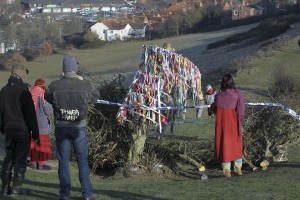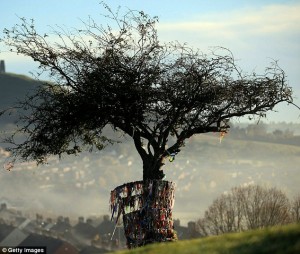 The Glastonbury Holy Thorn tree, said to be descended from the miraculous hawthorn planted by Joseph of Arimathea 2000 years ago after reaching landfall in England, has been hacked down to a 6-foot stump. Vandals cut off all the branches under cover of darkness Thursday night, leaving behind only the stump festooned with the prayers of pilgrims.
The Glastonbury Holy Thorn tree, said to be descended from the miraculous hawthorn planted by Joseph of Arimathea 2000 years ago after reaching landfall in England, has been hacked down to a 6-foot stump. Vandals cut off all the branches under cover of darkness Thursday night, leaving behind only the stump festooned with the prayers of pilgrims.
Authorities speculate that the violence might have been done in reaction to Wednesday’s annual cutting ceremony in which a budding sprig is cut from another Glastonbury Holy Thorn relative on the nearby grounds of the Church of St. John and presented to the Queen to adorn her Christmas table. The timing is certainly a notable coincidence. Another theory going around is that it was an act of vengeance against Edward James, the recently indicted major shareholder of the Crown Currency Exchange, a company which went under in October leaving 8,000 creditors short £16 million ($25 million). Inter-denominational conflict is also a possibility.
 According to legend, Joseph of Arimathea, the wealthy man who gave his tomb to hold the body of Christ crucified, landed on the coast of England a mile or so away. He and his party trudged to the hill then rested on the spot thereafter dubbed Weary-all-Hill (now Wearyall Hill) in honor of their eponymous weariness. St. Joseph thrust his staff, a dried hawthorn branch that once belonged to Jesus, into the ground and the staff miraculously grew into a tree. It also miraculously blooms twice a year, once in the spring along with every other tree, and once at Christmas. That’s the miraculous bit.
According to legend, Joseph of Arimathea, the wealthy man who gave his tomb to hold the body of Christ crucified, landed on the coast of England a mile or so away. He and his party trudged to the hill then rested on the spot thereafter dubbed Weary-all-Hill (now Wearyall Hill) in honor of their eponymous weariness. St. Joseph thrust his staff, a dried hawthorn branch that once belonged to Jesus, into the ground and the staff miraculously grew into a tree. It also miraculously blooms twice a year, once in the spring along with every other tree, and once at Christmas. That’s the miraculous bit.
Interestingly, trees grown from seeds and planted cuttings of the Holy Thorn do not bloom twice a year; only grafted ones, and there are several of those grafts dotting the landscape in and around Glastonbury.
A major pilgrimage site in the Middle Ages, the tree was seen as a symbol of Popish superstition and cut down and burned by Cromwell’s Puritan troops during the English Civil War, but in secret the faithful kept its roots and propagated cuttings therefrom ensuring that the tree would continue to live on in its descendants. The current Wearyall Hill tree was planted from one of those heritage pieces in the early ’50s.
Police are going door to door and interviewing potential witnesses. The spot is a popular one for runners and dog walkers so there’s a chance someone might have seen something probative in the wee hours. Meanwhile, Katherine Gorbing, the director of Glastonbury Abbey, holds out hope that the tree will grow back from the large remaining stump.
Hawthorns are sturdy, and this wouldn’t be the first time the Wearyall Holy Thorn recovered from a vicious sawing. According to an 18th century history of Glastonbury, the tree had a double trunk in Queen Elizabeth’s time. A devout Puritan took offense at the tree and sawed off the larger of its trunks. He was prevented from getting to the second one by an unfortunate, some say miraculous, sawing accident which severely cut his leg and, when a bark chip flew up, put out one of his eyes. The hewn trunk, now on the ground and connected to the roots by only a tiny segment of bark, continued to bloom for 30 years as did the intact trunk.